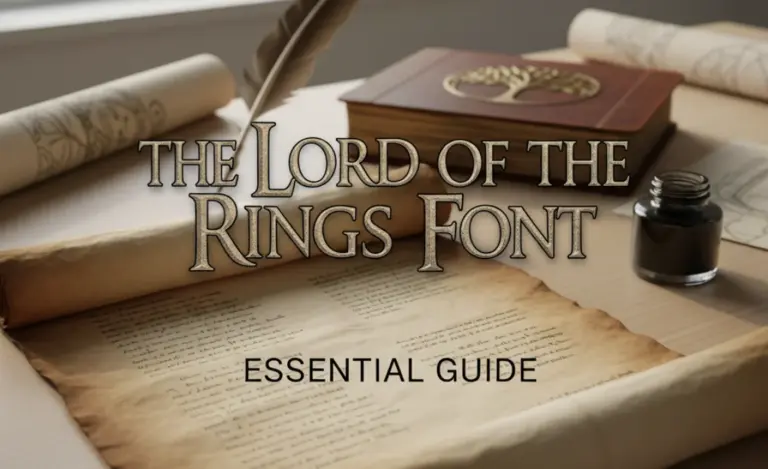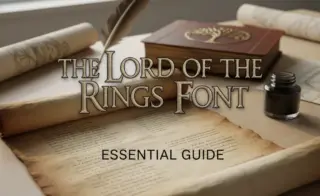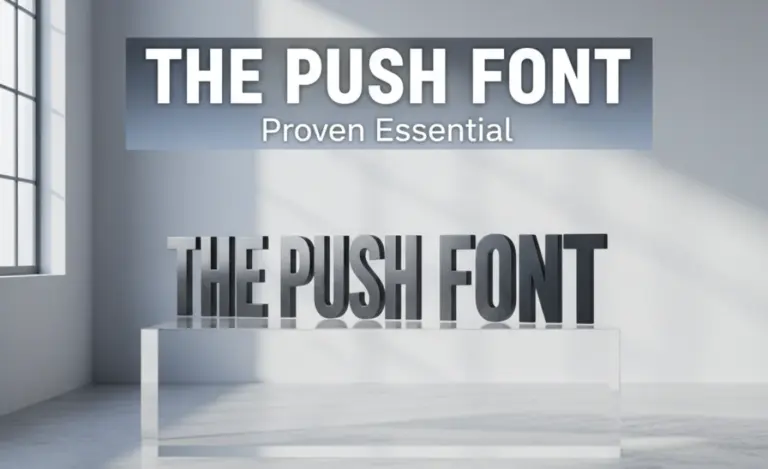The Lana Del Rey font is all about capturing her signature ethereal, nostalgic, and slightly vintage aesthetic. It’s a style characterized by elegant, often flowing script or serif fonts that evoke a sense of timeless romance and melancholic glamour. Finding the right font means channeling this unique vibe to enhance your own creative projects.
Have you ever seen a design that just screams “Lana Del Rey”? That’s the magic of her signature font style! It’s like a whispered secret from a bygone era, blending vintage charm with a dreamy, romantic feel. Many creatives, from designers to bloggers, find themselves drawn to this distinctive look but struggle to pinpoint the exact fonts that capture its essence. It’s easy to get lost in a sea of options. But don’t worry, this guide is here to demystify the “Lana Del Rey font” and help you easily find and use fonts that ooze that iconic vibe. We’ll break down the key characteristics and guide you through selecting the perfect typeface for your projects, ensuring your visuals have that touch of melancholic glamour you’re after.
Understanding the “Lana Del Rey” Aesthetic
Before we dive into specific fonts, let’s unpack what makes a typeface feel like it belongs in Lana Del Rey’s artistic universe. Her music and visual identity are deeply intertwined, often featuring:
- Nostalgia and Vintage Charm: Think of old Hollywood glamour, faded photographs, and classic romance novels.
- Ethereal and Dreamy Quality: A sense of softness, flow, and a slightly melancholic, faraway feeling.
- Romantic Elegance: Graceful curves, delicate strokes, and a sophisticated yet accessible feel.
- A Touch of Americana/Retro: Elements that nod to mid-20th century American culture, from diners to classic cars.
- Handwritten or Brush-like Qualities: Even in more formal fonts, there’s often an organic, human touch.
These elements combine to create a feeling that is both instantly recognizable and deeply evocative. It’s less about a single font and more about a curated aesthetic that the right typography can powerfully convey.
Identifying Key Font Characteristics for the Lana Del Rey Style
When searching for fonts that embody the Lana Del Rey aesthetic, certain typestyle characteristics often emerge. These are the building blocks we’ll look for:
Serif Fonts: The Foundation of Elegance
Serif fonts, with their small decorative strokes (serifs) at the end of letter diagonals and lines, are a cornerstone of the vintage and elegant feel. For the Lana Del Rey style, we’re looking for specific types of serifs:
- Old-Style and Transitional Serifs: These fonts, inspired by classic calligraphy and early printing, often have a graceful slant and organic stroke variation. Examples include typefaces with a clear contrast between thick and thin strokes, resembling hand-lettering.
- Slab Serifs (Used Sparingly): While less common, a softer, rounded slab serif can sometimes add a retro, even slightly diner-esque feel, reminiscent of her Americana influences.
- High Contrast: A noticeable difference between thick and thin strokes within letters adds a sense of drama and sophistication.
- Slightly Condensed or Expanded: Depending on the desired mood, a subtly condensed font can feel more formal, while a slightly wider one can feel more relaxed and airy.
Script Fonts: The Flow of Emotion
Script fonts mimic handwriting, and they are essential for capturing the dreamy, romantic, and personal side of Lana’s style. Key features here include:
- Flowing Cursive: Letters that connect smoothly, creating a fluid, elegant line.
- Brush Strokes: Fonts that have a distinct brush-like texture or varying stroke widths, adding an artistic, handmade feel.
- Swashes and Ligatures: Optional decorative flourishes on letters or connections between letter pairs that enhance the ornate and romantic quality.
- Ballpoint or Fountain Pen Style: Some scripts can evoke the feel of classic penmanship, adding a nostalgic touch.
Sans-Serif Fonts: Modern Touches with Retro Flair
While not typically the primary focus, sans-serif fonts can be used strategically to provide balance or a more contemporary edge. For the Lana Del Rey vibe, look for:
- Geometric or Humanist Sans-Serifs: A clean, readable sans-serif can ground a design. Geometric sans-serifs (based on simple shapes like circles and squares) can feel retro, while humanist sans-serifs (with more organic, varied strokes) offer a softer, friendlier touch.
- Slightly Rounded Edges: This can soften the sharpness of a sans-serif and make it feel more approachable and vintage.
- Retro-Inspired Designs: Certain sans-serifs deliberately evoke mid-century modern or vintage signage.
Essential “Lana Del Rey Font” Picks and Alternatives
The term “Lana Del Rey font” is often used to describe a style, rather than a single typeface. However, certain fonts and font families are frequently associated with her visuals or perfectly capture that distinct aesthetic. Here are some top picks and excellent alternatives:
Iconic Styles and Inspirations
While Lana Del Rey herself hasn’t officially endorsed a single font, her album art, music videos, and branding often lean into specific typestyles. These are the general categories that resonate most:
- Old Hollywood Scripts
- Classic Serif Typefaces with Romance
- Vintage Signage Inspired Fonts
Top Font Picks that Nail the Vibe
Finding fonts that embody this aesthetic is about looking for elegance, flow, and a touch of nostalgia. Here are some categories and specific examples:
Elegant Serif Fonts
These fonts provide a classic, sophisticated anchor, perfect for titles and headlines that demand attention with grace.
- Playfair Display: A strong contender with high contrast and bracketed serifs, reminiscent of 18th-century designs. It offers a luxurious and dramatic feel, perfect for evoking a sense of vintage opulence. Its many weights allow for versatile use.
- Cormorant Garamond: Inspired by the classic Garamond typeface, Cormorant offers a more delicate and calligraphic feel. Its light weights are incredibly airy and romantic, while the heavier weights are still refined. It’s a beautiful choice for evoking a soft, ethereal quality.
- Crimson Text: A more robust yet still elegant serif, Crimson Text offers a classic look suitable for longer texts or strong headings, bringing a sense of authoritativeness with a romantic undertone.
Dreamy Script Fonts
Script fonts are crucial for that personal, flowing, and emotive touch. They add a sense of artistry and spontaneity.
- Great Vibes: This is a popular choice for its flowing, elegant connected script. It has a slightly formal yet romantic feel, with beautiful swashes that add a touch of flourish reminiscent of classic calligraphy.
- Alex Brush: If you’re looking for something a bit more casual and brush-like, Alex Brush offers a playful yet still elegant script. It mimics hand-painted lettering with a slightly rougher edge, adding character and soul.
- Dancing Script: This font has a charming, informal feel with a good amount of bounce and variation in its baseline. It’s friendly and whimsical, perfect for adding a personal, almost diary-like touch.
Retro & Display Fonts
These fonts can add a unique flair, pulling directly from vintage signage, emblems, or artistic lettering styles.
- Lobster: A very popular, bold, and friendly script font that has a retro feel. It’s often used for eye-catching headlines and has a distinct personality that can bring a fun, vintage vibe.
- Pacifico: Another well-loved script with a distinctively retro, summery, and casual feel. It’s smooth, flowing, and has a vintage 1950s surfboard vibe that can also fit a particular nostalgic mood.
- League Gothic (or similar condensed sans-serifs): While sans-serif, a tall, condensed style like League Gothic can sometimes be used in a retro-stylized context for strong headings that feel very classic and impactful, akin to old movie posters.
Where to Find These Fonts
Thankfully, many of these beautiful typefaces are accessible. Here are some key places to look:
- Google Fonts: A fantastic, free resource offering a vast library of high-quality fonts, including Playfair Display, Cormorant, Crimson Text, Great Vibes, Alex Brush, Dancing Script, Lobster, and Pacifico. You can easily integrate these into websites.
- Adobe Fonts: If you’re an Adobe Creative Cloud subscriber, you have access to an extensive collection of professional fonts, including many elegant serifs and scripts.
- Font Squirrel: Offers a curated selection of free fonts for commercial use, often including unique display and script options.
- MyFonts / FontShop: These marketplaces offer a huge range of premium fonts, from independent foundries to major type houses.
How to Use “Lana Del Rey” Fonts in Your Designs
Simply picking the right font isn’t the whole story. How you use it makes all the difference. Here’s how to effectively channel the Lana Del Rey aesthetic:
1. Harmony is Key: Pairing Fonts
Rarely does one font do all the work. Effective pairing is crucial. A common strategy is to combine an elegant serif or display font for headlines with a clean, readable sans-serif for body text.
Example Pairing:
- Headline: Playfair Display Bold (for that luxurious, vintage feel)
- Body Text: Open Sans (a clean, modern sans-serif that complements without competing)
Another approach is to pair a dramatic script header with a simpler serif for supporting details.
Example Pairing:
- Main Title: Great Vibes (for that romantic, flowing touch)
- Subtitle/Details: Crimson Text (provides a classic, readable structure)
2. Color Palette: Enhancing the Mood
The colors used alongside your chosen fonts play a massive role. Think:
- Muted Tones: Soft pastels, dusty rose, faded blues, creamy whites, and deep burgundies.
- Black and White: Classic, dramatic, and timeless, often used for high-contrast impact.
- Gold or Metallic Accents: Adds a touch of glamour and luxury.
These colors, when applied to fonts with the right characteristics, amplify the nostalgic and dreamy atmosphere.
3. Layout and Spacing: Creating Air and Flow
Lana’s aesthetic often has a sense of spaciousness and deliberate composition. Consider:
- Ample White Space: Don’t cram elements together. Give your text and design breathing room.
- Letter Spacing (Kerning): Pay attention to the spacing between individual letters, especially in headlines. Slightly looser spacing can feel more elegant and vintage. Understanding typography tools is key here, and resources like those on Adobe’s typography guides can offer insights into fine-tuning character spacing.
- Line Height (Leading): For body text, ensure lines are not too close together, prioritizing readability and a graceful flow.
4. Image Integration: Setting the Scene
Fonts are one part of the visual puzzle. Pair your chosen typography with imagery that matches the mood:
- Vintage photography
- Dreamy, soft-focus landscapes
- Cinematic portrait shots
- Elements of Americana or retro iconography
The visual elements and typography should tell a cohesive story.
Designing with “Lana Del Rey” Fonts: Practical Examples
Let’s explore how these principles translate into real-world design applications:
For Bloggers and Website Owners
Goal: Create an inviting, atmospheric website that draws visitors into your content.
- Headings: Use an elegant serif like Playfair Display or a flowing script like Great Vibes for your blog post titles.
- Navigation & Buttons: A clean sans-serif like Lato or Montserrat for readability.
- Body Content: A slightly more classic serif like Merriweather or a humanist sans-serif like Source Sans Pro works well for longer articles.
- Banners & Quotes: Incorporate a decorative script or a retro display font for eye-catching quotes or impactful banners.
Example: A travel blog focusing on vintage destinations could use a deep teal as a primary color, creamy off-white backgrounds, and pair Playfair Display for headlines with Open Sans for body text, overlaid on faded, sepia-toned travel photos.
For Graphic Designers & Branding Specialists
Goal: Develop a unique brand identity that resonates with a specific nostalgic or romantic audience.
- Logo Design: Consider a custom logotype using a modified script or a distinctive serif. If using existing fonts, pair a strong serif for the company name with a subtle sans-serif for a tagline.
- Packaging: For artisanal products (e.g., candles, stationery, beauty products), use scripts for product names and elegant serifs for ingredients or descriptions.
- Social Media Graphics: Script fonts or vintage inspired display fonts are excellent for quote graphics, event announcements, or promotional posts that need to stand out with personality.
Table: Brand Identity Font Pairing Example
| Brand Type | Headline/Logo Font | Body Text Font | Accent Font (Optional) | Mood/Keywords |
|---|---|---|---|---|
| Ethereal Wedding Planner | Cormorant Garamond (Light) or Great Vibes | Merriweather Sans | – | Romantic, Dreamy, Elegant, Soft |
| Retro Cafe/Diner | Lobster Two or a vintage slab serif | Roboto Slab (Light) | Pacifico (for specials) | Nostalgic, Fun, Casual, Americana |
| Indie Music Artist | Playfair Display (Bold) or Alex Brush | Lato | – | Melancholic, Artistic, Vintage, Glamorous |
For Students and Beginners
Goal: Learn to apply typographic principles to create aesthetically pleasing designs.
- Start Simple: Begin by experimenting with font pairings using free tools like Google Fonts.
- Focus on Readability: Always ensure your text is easy to read, especially for longer passages.
- Practice Hierarchy: Use different font weights, sizes, and styles to guide the reader’s eye from the most important information to the least.
- Study Examples: Look at album covers, movie posters, and book designs that capture the Lana Del Rey aesthetic and analyze the typography used. The Artsy definition of the Lana Del Rey aesthetic can be a great starting point for visual inspiration.
Tips for Finding Your Own “Lana Del Rey” Font
While specific fonts can be recommended, the best approach is to develop an eye for the style. Here’s how:
- Analyze Inspiration: When you see a design you love that feels like Lana Del Rey, pause and look closely at the typography. What type of font is it? What are its characteristics?
- Use Font Identifier Tools: If you see a font you can’t identify, browser extensions like WhatFont or websites like WhatTheFont can help you discover its name.
- Experiment with Keywords: When searching font foundries or libraries, use terms like “vintage script,” “elegant serif,” “retro display,” “calligraphy,” “romantic,” “nostalgic,” “old Hollywood,” or “Americana.”
- Consider Font Families: Many fonts come in families with various weights (light, regular, bold) and styles (italic, condensed). This allows for more versatile use within a single typeface.
- Test Drive is Essential: Always preview the font with your own text. See how it looks at different sizes and in different contexts before making a final decision.
Common Pitfalls to Avoid
To ensure your design effectively captures the desired aesthetic, be mindful of these common errors:
- Overuse of Scripts: While beautiful, too many connecting scripts, especially in large blocks of text, can become illegible.
- Poor Font Pairing: Clashing font styles can detract from the intended mood. Always ensure your chosen fonts complement each other.
- Ignoring Readability: A font




Leave a Comment